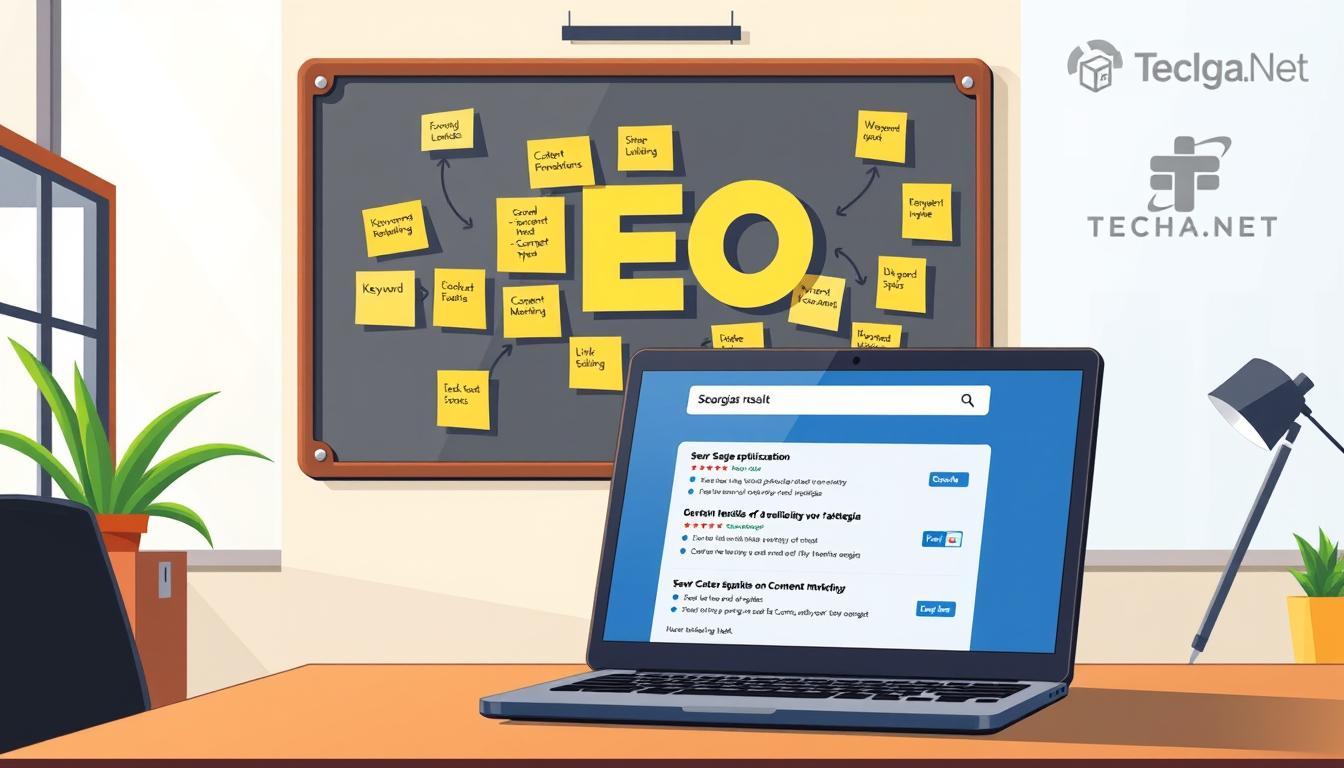In today’s digital landscape, staying ahead requires more than just a strong online presence. It’s about understanding what drives your audience and adapting to the ever-changing trends. As we look toward 2025, ecommerce is set to evolve with new technologies and growth opportunities. To thrive, we must align our efforts with these advancements.
At the core of our approach is a deep understanding of customer search behavior. By analyzing what users are looking for, we can create content that resonates. Competitor strategies also play a crucial role. Learning from their successes and failures helps us refine our own methods.
High-quality content remains a cornerstone of our strategy. It’s not just about keywords; it’s about delivering value. A well-optimized site ensures users stay engaged, while effective keyword targeting helps us rank higher in search results. Together, these elements form a solid foundation for success.
Key Takeaways
- Align your efforts with emerging ecommerce trends for 2025.
- Understand customer intent to create relevant content.
- Analyze competitor strategies to refine your approach.
- Focus on high-quality content and optimal site performance.
- Use effective keyword targeting to improve search rankings.
Introduction: The Future of Ecommerce and SEO in 2025
As we approach 2025, the intersection of ecommerce and search engine innovation is reshaping the online landscape. Businesses must adapt to these changes to stay competitive and relevant. The future holds immense potential for those who embrace new technologies and trends.
Innovation is at the heart of this transformation. Emerging technologies like AI and machine learning are revolutionizing how we approach online marketing. These tools enable businesses to better understand customer behavior and optimize their strategies for maximum impact.
Thorough research is essential to anticipate shifts in the search engine landscape. By analyzing data and trends, we can stay ahead of the curve. Blogs and content marketing play a crucial role in sharing industry expertise and driving visibility.
Quality pages and closely monitored search results are key to enhancing online presence. We are committed to fostering innovation that benefits our audience. Join us as we explore actionable tips to make the most of these upcoming opportunities.
Decoding Ecommerce Trends and Emerging Technologies
The ecommerce landscape is rapidly evolving, driven by cutting-edge technologies and shifting consumer behaviors. As we look toward 2025, businesses must adapt to these changes to stay competitive and relevant. This section explores the latest innovations, growth opportunities, and their impact on search engine efforts.

Latest Innovations Shaping Ecommerce
Artificial Intelligence (AI) and machine learning are revolutionizing ecommerce. These technologies enable businesses to analyze user behavior and deliver personalized experiences. For example, AI-powered product recommendations can boost sales by up to 15%.
Another key innovation is quick commerce, which focuses on ultra-fast delivery. By 2027, this market is expected to reach $40 billion in revenue. These advancements are not just enhancing user experience but also influencing search engine algorithms.
Future Growth Opportunities in 2025
Global ecommerce sales are projected to grow from $5.8 trillion in 2023 to over $8 trillion by 2027. This growth presents immense opportunities for businesses that align their strategies with emerging trends.
Companies like 10&AY have seen a 345% increase in conversion rates after implementing AI for demand forecasting. Such examples highlight the potential of investing in optimization and leveraging search engine signals.
How Trends Impact Our SEO Efforts
Google’s evolving algorithms favor businesses that adopt the latest technologies. Achieving high ranking requires effective link building and ensuring an optimal user experience. As Deepankar Rustagi notes,
“Data-backed strategies are essential for staying ahead in the competitive digital space.”
We also focus on integrating links and optimizing content to align with search engine signals. This approach not only improves visibility but also drives better results. Emil Lim emphasizes,
“Continuous adaptation is key to maintaining a strong online presence.”
| Trend | Impact on SEO |
|---|---|
| AI and Machine Learning | Enhances personalization and user experience |
| Quick Commerce | Influences local search rankings |
| Global Ecommerce Growth | Expands opportunities for international optimization |
By understanding these trends and their implications, we can refine our strategies to achieve better ranking and visibility. The future of ecommerce is bright, and those who adapt will thrive.
Implementing SEO strategies for increased visibility
To stay competitive, businesses must adopt a clear and actionable approach to enhance their online presence. This involves understanding the tools and techniques that drive engagement and deliver measurable results. Let’s explore practical steps to refine your digital footprint.

Keyword Research and Content Optimization
Conducting in-depth keyword research is the foundation of any successful strategy. By analyzing what your target audience is searching for, you can create content that resonates. Tools like SEMRush and Ahrefs help identify high-performing keywords and track competitor activity.
Once you’ve identified the right keywords, strategically distribute them throughout your content. Craft compelling meta descriptions that align with search engine requirements. As Oluwatosin Olatujoye notes,
“Quality content paired with the right keywords can significantly boost your rankings.”
On-Page Tactics to Boost Rankings
Optimizing on-page elements is crucial for better performance. Enhance title tags to include primary keywords and ensure they are concise yet descriptive. Improve internal link structures to guide users and search engines through your site effectively.
Fast loading times are another critical factor. Slow websites can deter users and harm rankings. Regularly monitor your site’s speed and make necessary adjustments. Neda Hovaizi emphasizes,
“A seamless user experience is key to maintaining high rankings.”
Leveraging Industry Insights for Better Visibility
Staying updated with industry trends ensures your strategy remains relevant. Analyze data to identify emerging patterns and adapt your approach accordingly. Tools like Google Analytics provide valuable insights into user behavior and content performance.
Having a dedicated expert within your team can make a significant difference. This person ensures authenticity and continual improvement, helping you stay ahead of the competition. By refining your strategy over time, you can adapt to changing search trends and audience needs.
Enhancing User Experience and Mobile Optimization
In the fast-paced world of ecommerce, user experience and mobile optimization are no longer optional—they’re essential. With over 50% of global web traffic coming from mobile devices, businesses must adapt to meet user expectations. A seamless experience can significantly impact engagement, retention, and conversions.

Designing for Engaging User Experiences
Creating visually appealing and intuitive layouts is key to capturing your target audience’s attention. A well-designed website ensures users can easily navigate and find what they need. As Raj Sardana notes,
“A user-friendly design not only enhances satisfaction but also boosts your rank on search engines.”
Fast-loading pages are equally important. Studies show that 53% of mobile users abandon sites that take longer than 3 seconds to load. Optimizing your post and page elements can make a significant difference in retaining visitors.
Mobile-First Strategies to Reach More Customers
Adopting a mobile-first approach ensures your website performs well on all devices. Responsive design is crucial, as it allows your content to adapt seamlessly to different screen sizes. Inger Sivanthi emphasizes,
“Mobile optimization is not just about design—it’s about creating a holistic experience that drives results.”
Here are some practical tips for mobile optimization:
- Use concise and descriptive title tags to improve visibility.
- Optimize images and videos to reduce load times.
- Ensure your marketing efforts align with mobile user behavior.
| Mobile Optimization Factor | Impact |
|---|---|
| Responsive Design | Improves user experience and search rankings |
| Fast Load Times | Reduces bounce rates and increases engagement |
| Local Search Optimization | Boosts visibility for nearby customers |
By focusing on these elements, you can create a website that not only ranks higher but also delivers a memorable experience for your audience. Learn more about the importance of mobile optimization to stay ahead in the competitive digital landscape.
Elevating Content Quality and Authenticity for SEO Success
Authentic, high-quality content is the cornerstone of long-term digital success. It’s not just about ranking higher; it’s about building trust and delivering value to your target audience. By focusing on creating meaningful content, we can establish a strong connection with users and foster lasting engagement.

Creating Valuable and Authentic Content
To resonate with your audience, start by addressing their most pressing questions. Content that provides clear answers builds credibility and positions your brand as a reliable source. As Abimbola Olayinka notes,
“Authenticity in content creation is non-negotiable. It’s what sets you apart in a crowded digital space.”
Here are some actionable tips to enhance content quality:
- Focus on topics that align with your audience’s interests and needs.
- Use descriptive tags to improve content discoverability.
- Optimize URLs to make them clear and user-friendly.
Maintaining Consistency for Long-Term Impact
Consistency is key to building a trusted brand. Regularly updating your content ensures it remains relevant and engaging. Natalie Lowe emphasizes,
“Consistency in messaging and tone reinforces your brand’s identity and fosters trust.”
Consider these strategies for consistent content creation:
- Develop a content calendar to plan and schedule posts.
- Monitor user feedback to refine your approach.
- Incorporate common search queries to enhance domain expertise.
By focusing on quality and consistency, we can create a seamless experience for our audience. For more insights on mastering these techniques, explore our guide on high-quality SEO optimization.
Leveraging SEO Tools and Data for Strategic Growth
Harnessing the power of analytics is essential for modern digital success. By using advanced tools and insights, we can make informed decisions that drive growth and improve our online presence. Let’s explore how to integrate these resources effectively.

Using Analytical Tools for Keyword Research
Tools like SEMRush and Ahrefs are invaluable for identifying high-performing keywords. They help us understand what our audience is searching for and track competitor activity. As Eric Bone notes,
“Accurate keyword research is the foundation of any successful strategy.”
Here’s a practical example: A business saw a 50% increase in organic traffic after optimizing for keywords identified through these tools. This tip highlights the importance of data-driven research.
Measuring SEO Performance and Rankings
Tracking metrics like click-through rates and user engagement is crucial. These indicators provide information on how well our content resonates with the audience. Daniel Ramsey emphasizes,
“Performance measurement is key to refining strategies and achieving long-term success.”
For instance, reducing bounce rates by 10% can lead to a 20% increase in conversions. This way of analyzing data ensures we stay on the right track.
Data-Driven Decisions to Enhance Online Presence
Interpreting data from tools like Google Analytics allows us to optimize every aspect of our efforts. Structured data, for example, can improve click-through rates by up to 30%. This tip shows how small changes can have a big impact.
Visual assets, like optimized images, also play a significant role in boosting search engine ranking. By focusing on these elements, we create a seamless user experience that drives results.
In summary, a systematic, data-driven approach is the most effective way to achieve strategic growth in an ever-evolving digital landscape.
Conclusion
Mastering digital growth requires a blend of creativity and data-driven insights. By focusing on keyword research and creating high-quality blog posts, we can build a strong foundation for success. These efforts not only improve engine ranking but also ensure our content resonates with the audience.
Adapting to the evolving ecommerce landscape in 2025 is essential. Staying ahead means integrating clear phrases and refining our approach based on emerging trends. This proactive mindset helps any business maintain relevance and visibility in a competitive market.
We encourage you to implement these strategies today. Start by analyzing your current efforts and making data-driven adjustments. With consistent effort, you’ll see tangible improvements in your digital presence and long-term growth.



